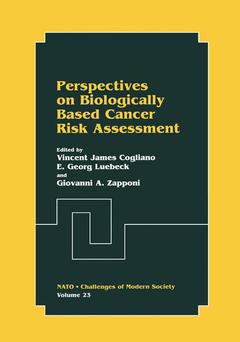Perspectives on Biologically Based Cancer Risk Assessment, Softcover reprint of the original 1st ed. 1999 Nato Challenges of Modern Society Series, Vol. 23
Langue : Anglais

The first meeting of the NATO/CCMS Pilot Study "Dose-Response Analysis and Biologically-Based Risk assessment for Initiator and Promoter Carcinogens" was held in Rome, Italy, in the spring of 1991, and was followed by annual or bi-annual meetings held in Germany, Greece, Netherlands, Portugal, USA, up to the end of 1995; in large part supported by NATO/CCMS grants or fellowships, and organized by Pilot Study participants. The Pilot Study activity has been characterized by a higly collaborative atmosphere, which was essential for a deep and detailed analysis of a problem on which different points of view, methodological approaches and regulations exist in the various member countries. The Pilot Study was aimed at proposing a carcinogenic risk assessment procedure which is based on a detailed analysis of the relevant biological processes, and may also consent the verification of hypotheses. The specific form of theoretical and mathe matical models is identified by considering and using the whole set of objective data available. The multidisciplinary approach of the pilot study is reflected by the struc ture of this book. Each chapter is the result of the cooperation of several authors from to produce a comprehensive manual that includes different countries; its objective was both theoretical and practical information.
1. Introduction.- 1.1. Dose-Response Assessment in Nato Countries.- 1.2. Future Directions in Dose-Response Assessment.- 1.3. Brief Considerations on Some Commonly Used Parameters.- 1.4. Structure of this Report.- 1.5. References.- 2. The Biological Basis of Cancer.- 2.1. Introduction.- 2.2. Cell Proliferation.- 2.3. Cell Proliferation and Mutation.- 2.4. Differences in Susceptibility.- 2.5. Mechanisms of Inhibition in Mutagenesis and Carcinogenesis.- 2.6. References.- 3. Sources of Data For Cancer Risk Assessment.- 3.1. Introduction.- 3.2. In Vitro and Short Term Testing.- 3.3. Trends in Animal Toxicology Testing.- 3.4. Cell Proliferation.- 3.5. Sources of Toxicokinetic Data.- 3.6. Inter- and Intra-Species Variability.- 3.7. References.- 4. Use of Biochemical and Molecular Biomarkers For Cancer Risk Assessment in Humans.- 4.1. Introduction.- 4.2. The Initiatory Complex and its Modulators.- 4.3. The Determinants of the Clonal Expansion of the Initiated Cells.- 4.4. Adjuvant Determinants of the Clonal Expansion.- 4.5. Conclusion.- 4.6. Acknowledgments.- 4.7. References.- 5. The Multistage Model of Carcinogenesis: A Critical Review of its Use.- 5.1. Introduction.- 5.2. Historical Antecedents of the Multistage Model.- 5.3. The Armitage-Doll Multistage Model.- 5.4. Derivation, Rationale and Mathematical Form of the Model.- 5.5. The “Linearized Multistage Model”.- 5.6. Time-Dependent Non-Constant Exposure Patterns: Their Influence on Multistage-Derived Risk Estimates.- 5.7. Consideration of Pharmakokinetics in Multistage Modeling.- 5.8. The Problem of Multiple Exposure: Multistage Carcinogenesis Theory and Additive and Multiplicative Models.- 5.9. Critical Review of the Model.- 5.10. Discussion.- 5.11. References.- 6. Biologically Based Models of Carcinogenesis.- 6.1.Introduction.- 6.2. A Brief History of Biologically-Based Cancer Models.- 6.3. Two-Mutation Clonal Expansion Model.- 6.4. Modes of Action of Carcinogens.- 6.5. Quantitative Formulation of the Model.- 6.6. Likelihood Construction and Estimation.- 6.7. Quantitative Analysis of Intermediate Lesions.- 6.8. Toxicokinetics in Biologically Based Risk Assessment.- 6.9. Interspecies Extrapolation.- 6.10. Implications for Low-Dose Extrapolation.- 6.11. References.- 7. Statistical Issues in the Application of Multistage and Biologically Based Models.- 7.1. Introduction.- 7.2. Characterization Of Models.- 7.3. Statistical Inference.- 7.4. Design Considerations for Low-Dose Problems.- 7.5. Sensitivity Analysis and Physiologically Based Toxicokinetic Modeling.- 7.6. Discussion.- 7.7. References.- 8. Informative Case Studies.- 8.1. Radon, Cigarette Smoke, and Lung Cancer: The Colorado Plateau Uranium Miners’ Cohort.- 8.2. Modeling Colon Cancer.- 8.3. Quantitative Analysis of Enzyme Altered Foci (EAF).- 8.4. The Role of Cell Proliferation in Urinary Bladder Carcinogenesis.- 8.5. N-Nitrosomorpholine: Comparison of Multistage Model and Two-Event Clonal Expansion Model.- 8.6. Calculation of Tetrachloroethylene Risk Estimates.- 8.7. Considerations for Benzene Toxicokinetic Extrapolation.- 8.8. References.- 8.9. Appendix A.- 9. Conclusions and Recommendations.- 9.1. Introduction.- 9.2. What does Each Source of Experimental Data Contribute to our Knowledge and Ability to Model?.- 9.3. What Kinds of Information are Needed to Develop a Biologically Based Model?.- 9.4. How does Linearity Enter into Empirical Models and Biologically Based Models?.- 9.5. How does a Biologically Based Model Help Us Understand Intraspecies Variability?.- 9.6. How D does a Biologically Based Model Help UsUnderstand Interspecies Variability?.- 9.7. What are the Uncertainties Associated with a Biologically Based Model?.- Contributors.
Date de parution : 09-2012
Ouvrage de 319 p.
17.8x25.4 cm
Thèmes de Perspectives on Biologically Based Cancer Risk Assessment :
Mots-clés :
DNA; apoptosis; cancer; carcinogenesis; carcinoma; cell; development; kinetics; liver; mutagen; mutagenesis; oncogene; research; toxicity; tumor
© 2024 LAVOISIER S.A.S.



